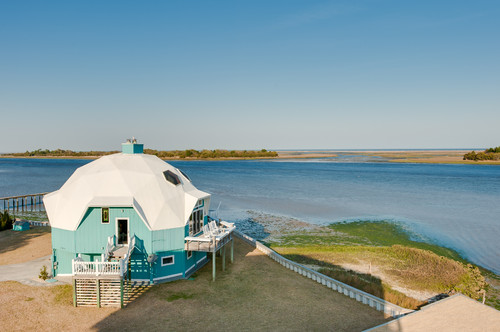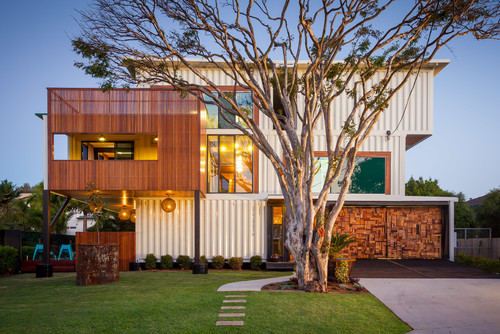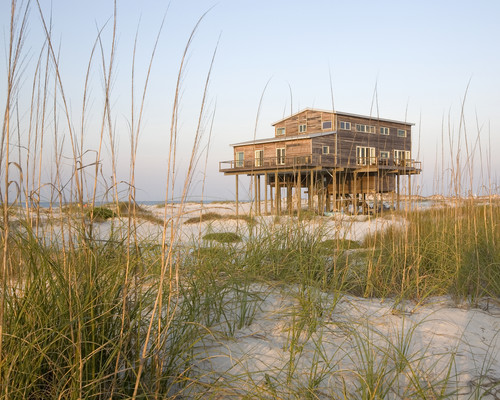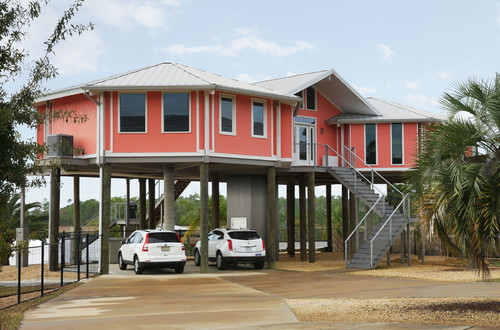
Shubin + Donaldson Architects, Inc. via Houzz
This week marks the end of the traditional hurricane season, which we weathered pretty well here in the U.S. Despite a few close calls, 2015’s Atlantic hurricane season rated below average, thanks in part to El Niño.
That got us thinking: If we escaped Mother Nature’s wrath this year, are we in for a doozy next year? After all, the flip side of El Niño was that the Pacific had its second most active season on record.
Never fear! We’re already preparing for ways to hunker down in case of stormy weather or a zombie apocalypse.
In a hurricane, your home is challenged to withstand massive winds, heavy rainfall, flooding, and debris pelting down like shrapnel. That’s a lot to ask, which is why the prospect of living in a hurricane zone can be so terrifying.
Certain homes, however, fend off hurricanes better than others—through either their shape, construction materials, or other ingenious fortifications or architectural features. So if you’re home shopping in a hurricane zone and want an added layer of protection, look for these types of residences to feel a bit safer once those 100-mph winds hit.
Dome homes
Monolithic “dome homes” are akin to modern-day igloos, made of a solid piece of concrete that allows even strong winds to slide easily over the top of the home—which comes in handy during hurricanes.
“This is critical because in a hurricane buildings don’t get blown over, they get vacuumed up. The wind actually sucks part of the building along with it as it is leaving,” says Walter Sedovic, principal and CEO of Walter Sedovic Architects. But the dome won’t provide much protection against rising water, according to Sedovic. That makes these designs ideal for areas that are prone to high winds but not flooding.
———
Shipping containers
Shipping containers are touted by companies that build with them as hurricane-resistant; their heavy steel construction makes them resistant to wind and water of any sort. That comes in handy on the high seas, but it can also work wonders on land, too. What’s more, you can link multiple shipping containers like building blocks to make a home.
That said, quality matters.
That said, quality matters.
“It really depends on how the containers were made,” says Sedovic. “If you’ve ever seen an accident with a tractor-trailer carrying those containers, you know those containers can split open.” Still, planted firmly on the ground, they sure stand a better chance than a wood shack.
———
Homes on stilts
Homes directly on the coast can escape the rising tide if they’re built on stilts—also called pilings or piers, depending on what part of the country you’re in.
“The principal reason is to allow a body of water that floods to pass underneath the building,” says Sedovic. This not only keeps the home and its belongings dry, it also helps it stay put. “It keeps the home from being washed away by a large mass of water,” he says.
———
Octagon homes
Octagon homes, like domes, allow wind to travel around the sides without much resistance. Plus, since these homes are typically on a pedestal, they offer flood protection, too.
Of course, there’s a downside to this type of design: If the home isn’t built right, it might turn into a liability more than a protection.
“If it’s lightweight, it might get blown into the next state,” says Sedovic. Instead of opting for cheaper, pre-fab models, homeowners should opt for designs using sturdier building materials such as reinforced steel.
———
Homes built from concrete and steel
Concrete and steel homes look like any other home on the outside: There are four straight walls, windows, and doors. However, storm protection is packed into the inside. With walls made of concrete and the roof and joists made of reinforced steel, the wind protection can be immense.
“Before, the tendency was for homes to be ripped apart at the seams as a result of the construction techniques that were employed, especially around the 1970s when coastal regions like Florida were in a housing boom,” Sedovic says. On the flip side, modern concrete and reinforced steel homes keep the corners of the home from ripping apart in high winds, offering more protection than siding or brick.
Shared from: http://www.realtor.com/advice/buy/hurricane-resistant-homes/





No comments:
Post a Comment